|
|
Mountain/Rock |
|---|---|
|
|
43.24320°N / 41.72762°E |
|
|
Mountaineering |
|
|
Summer |
|
|
13255 ft / 4040 m |
|
|
Dombai-Ulgen - Great Bison
Dedication
This page is respectfully dedicated to the memory of my friends who were lost on Dombai-Ulgen
Nikolay Teplov (1938-1971) Eastern Dombai-Ulgen Southern wall
Nikolay Vetchinkin (1949-1975) Western Dombai-Ulgen Sasorov's route
About Dombai-Ulgen
Mount Dombai-Ulgen is the highest peak of the Western Caucasus. There are different translations of the name “Dombai-Ulgen”: "Wounded Bison", "Killed Bison" and "Great Bison". Any climber who has ever climbed or has ever been near Dombai-Ulgen comes to realize that this mountain is indeed great. So, for the mountaineering world, the proper translation of the name “Dombai-Ulgen” is “Great Bison”.There is no reason to discuss which of the Caucasus Mountains is greater, but Ushba and Dombai-Ulgen, two mountaineering diamonds of the Caucasus are the most significant foundations of mountaineering and wall climbing in Russia and other republics of the former Soviet Union. The two mountains are located in different areas and about hundred kilometers from each other, but they do share a common climbing history. Many generations of mountaineers have followed the same routine, first climbing Dombai-Ulgen and only then ascending Ushba.
For instance, famous climbers of the former times, Boris Aleynikov and Alexandr Aleksandrov, were the first Russians to have climbed Dombai-Ulgen in 1933, and then Ushba in 1938. Later, Vladimir Budanov and his team made the first wall ascent to Dombai-Ulgen in 1938, and then the first traverse of Ushba summits in 1940. After World War II, Lev Mishliev and Oleg Kosmachev, outstanding wall climbers, also made their first record ascents to Dombai-Ulgen and only then laid new routes to Ushba.
Dombai-Ulgen ascents enjoyed their highest popularity between 1960 and 1980. Only in 1970, more than 50 climbers ascended Dombai-Ulgen by high grade wall routes.
In 2014, we shall celebrate the centennial of the first successful ascent to Dombai-Ulgen, and it is a good enough reason to introduce Great Bison to the SP community.
Overview
Dombai-Ulgen is located on the border of Russia (the Karachay-Cherkess Republic) and the Abkhazian Republic (former part of Georgia) to the north-east of Dombai. The place is traditionally called the Dombai glade, though today, it is a town surrounded by fir woods. The huge rocky and ice massif of Dombai-Ulgen can be seen practically from any point of Dombai.The main massif of Dombai-Ulgen is the site of the Great Caucasus ridge. The main massif is about 2,5 km long, broken by steep kilometer-long rocky walls in all directions. From the south-west, the massif ends with the Dombai pass, and from the east, with the Western ridge of Bu-Ulgen mountain, the so-called “Bu-Ulgen Saw”.
The main massif consists of three summits: Grand (Main) Dombai-Ulgen 4040 m high, Western Dombai-Ulgen 4036 m high, and Eastern Dombai-Ulgen 3950 m high. Near the Western summit in the South-Western ridge there stands a huge gendarme, the so-called “CDSA Peak”. In the northern spur of the Grand Dombai-Ulgen, Malij (Small) Dombai 3800 m high is located. It is separated from the main massif by the Dombai Saddle (Fischer's Saddle). To the south-west from the Dombai pass, there is Southern Dombai 3585 m high. Three valleys surround the main massif: Northern Ptysh, Southern Ptysh and Bu-Ulgen. At the bottom of rocky walls there lie three little glaciers: the Southern Dombai glacier, the Western Dombai glacier and the Eastern Dombai glacier.
More than 20 routes lead to the summits of the main massif. The classical route to the Grand Dombai-Ulgen summit is 3B Russian grade. There are also two 4B grade routes to the Western summit. All other routes to Dombai-Ulgen summits are more complicated rock climbing routes 5A, 5B and 6A Russian grade. Traverses of three summits of the massif in both directions are 5B grade routes. Average time needed for climbing 5B route on Dombai-Ulgen massif is 4 days.
Climbing history
1914 - First Ascent
At the beginning of the 20th century, the Caucasus was actively investigated by Russian and European climbers under the auspices of the Russian Mountain Society. Two German climbers, Oscar Schuster and Werner Fischer, were among them. By 1914, they had already made more than 20 first ascents on Southern Ushba, Aday-Hokh, Lagau and others. In the summer of 1914, climbers found a way to the Dombai Sedlo (Saddle) and ascended the Grand Dombai-Ulgen by the Northern ridge. After this ascent, the Dombai Saddle has been often called the Fischer's Saddle.
Having descended from the summit, Schuster and Fischer learned about the beginning of the war (Germany declared war to Russia on August 1, 1914). Finding themselves on the enemy territory, the climbers decided to get to Germany secretly, through Turkey. They hiked over 65 kilometers to the Black Sea coast, but were detained in Sukhumi by the Russian authorities and put into a Prisoner-of-war camp. Oscar Schuster died of disease in a POW camp near Astrakhan at the end of 1917.
When World War I broke out, mountaineering in the Caucasus stopped. Climbers came back to Dombai again only in 1925.
1937 – Western Summit
Since 1925, mountaineering in the Dombai area has been actively developing. Climbers’ experience had been growing steadily, and by 1933, some of them started planning ascents to Dombai-Ulgen. That year, Schuster-Fischer's ascent to the Main Summit was repeated. But it was only four years later, in 1937, that V.Sasorov’s team (K.Sobolev, A.Ashkinazi, M.Korshunov) successfully ascended the Western Summit from the west through the characteristic shoulder of the South-Western ridge, the so-called "triangle". After reaching the triangle top, the climbers began to search for a further way to the summit through the huge gendarme (aiguille), the CDSA Peak. They found a wide comfortable shelf hardly visible from the ridge that crossed the northern face of the CDSA Peak. The shelf opened the way from the triangle to the Western Summit. Thanks to this discovery, Sasorov's route became the main and the most convenient way of descending from the Western Summit. Among climbers, the shelf became known as “the Tractor Shelf”.
During World War II, the Western Caucasus became the site of fierce battles. German armies tried to get to Georgia through passes in the Great Caucasus Range. Many climbers participated in those defense operations. Mountaineering stopped again.
1948 - Eastern Summit
In 1945, Dombai mountaineering camps opened their doors again. The attention of climbers with prewar experience was drawn to unapproachable Eastern Dombai-Ulgen. Among them was Victor Nesterov. In 1946, he ascended Grand Dombai-Ulgen by the Northern Ridge from Bu-Ulgen valley and had a good possibility to observe the Northern wall of the Eastern Summit. Quite possibly, he found it too complicated and decided to look for alternative routes.
In 1947, Nesterov was looking for ways to the Southern wall of the Eastern Summit through the Dombai pass and was planning the route line of the future ascent. The next summer, V. Nesterov, A.Aleksandrov, K.Kuzmin, and A.Volzhin approached the Southern wall, but on the way, Aleksandrov injured his hand, and the ascent was made by three climbers. In 3 days they ascended the 1000 meter high Southern wall, and on July 15, 1948, they were standing at the summit.
It is widely considered that their ascent and A.Maleinov’s team ascent to the Southern Ushba in 1946 opened up an era of wall climbing in the Caucasus.
1951, 1954 – Traverses
In1948, after all summits of the main massif had been conquered, the most experienced mountaineers became focused on traverses of three summits, including the problematic part of the ridge from the Grand to the Eastern summit. In 1951, Sergey Kalinkin’s team passed three summits from West to East for the first time. The ascent lasted 9 days. The ridge between the Grand and the Eastern summits turned out very difficult. The members of Kalinkin’s team claimed that it was impossible to traverse the ridge in the opposite direction.
But already in 1954, younger climbers under the leadership of Vladimir Davidov (V.Davidov, V.Nekrasov, V.Dubinin, V.Zubakov, V.Zhirnov) passed a traverse of three summits from East to West. The climbers reached the Eastern Summit by the Southern wall and laid a new route to it. Even now, this ascent is considered an outstanding achievement. The route they chose then has never been repeated.
1960 Tragedy
Ascents to mountains like Dombai-Ulgen can never be absolutely safe. Fifteen climbers in total were lost on the main massif (Dombay-Ulgen is rated 10-th in the list of the most dangerous mountains of the former USSR).
The most dramatic accident at Dombay-Ulgen happened in 1960, during the ascent of Igor Erokhin's party. Igor Erokhin was the author of high-speed mountaineering tactics based on athletic climbing and new tactical scheme for a party of four climbers, the so-called “Parovoz” (steam train). There were a lot of discussions about it. Some climbers did not accept his tactics for ethical and safety reasons: one climbs and the others use ropes; sometimes, there were as many as four climbers simultaneously connected to one rope. However,many were impressed by Erokhin’s ascents.
At the beginning of March, 1960, Erokhin’s team planned the first winter traverse of Dombay-Ulgen. They passed the most difficult part of the route from the Dombai pass to the triangle and began to climb the CDSA Peak. Nobody knows what really happened on the so-called psychological wall of the CDSA Peak, but all four climbers slipped from the Southern wall to a depth of 1000 m, and all four were lost. Two ropes were connected to each other by carbines, in accordance with Erokhin’s tactics. The accident became the main argument in the “Parovoz” tactics dispute.
1963 Earthquake
Speaking of Dombai-Ulgen climbing history, it is impossible tp ignore the events of 1963. A lot of articles and reports about it are available in Russian and on the Internet. I was a thirteen-year-old boy living in town far from the mountains when all this happened. Absolutely accidentally, I got a magazine with an article headlined “Courage” about the great mountain rescue operation. It was the first thing about mountains and mountaineering I read about in my life. I was reading the short article time after time and could not believe that all these mountains, walls, rock falls and climbers really existed…
The Caucasus is an area with medium seismic activity. Earthquakes are not very common, and usually, they are local and strong. The only quake in the 20-th century that really affected mountaineering in the Caucasus was the quake of 1963. Its power was up to 9 points, and the epicenter was located just several kilometers from the Dombai-Ulgen massif. The quake ruined the banks of the Southern Ptish Valley the ridge and walls of Dombai-Ulgen massif. The terrain of the Dombai-Ulgen walls was significantly changed.
In the summer of 1963, many climbing teams came to Dombai to take part in the USSR mountaineering championship. At the moment of the quake three teams were ascending the Grand and the Eastern Summits of Dombai-Ulgen by high grade routes. The earthquake began at night and was accompanied by a strong thunderstorm. At that time, the climbers were resting in the bivouacs established on the routes.
Vladimir Shataev’s team was descending from the summit after their ascent and stayed on the ridge in more or less safe conditions. In the morning, they saw a red rocket on the northern wall and understood that Romanov's team needed help. Two climbers from the party continued descending, while the two others turned back and began traversing the wall in the direction of Romanov’s party, but their attempts to find the way failed. They were stopped by intensive rock falls.
Vladimir Kavunenko and his partner were spending the night under the hanging site of the wall. Thanks to it, they were not injured by stones, but lost all the gear, including ropes. As Vladimir writes in his book, in the morning they saw that the glacier had turned black from stones. The wall shocks became weaker, but stones continued to fly around them. They realized that nobody could help them at the moment and decided to descend from the wall alone, using free climbing. They were indeed lucky to make this 200 m climb down safely.
On the glacier they met other climbers and learned that Romanov's team on the North- Eastern wall had given a distress signal. Many of the climbers they met were shocked by the events and didn’t know what to do. Kavunenko realized what could have happened to his friends on the wall and felt that he should return to the hell from which he had just escaped. Shortly, Vladimir managed to find the climbers who had enough courage to do that, and together they started to climb in the direction of Romanov's team. Their attempt was successful. It took them two days to get to the place. They found Romanov's party in a very bad condition. One climber was dead, another lay unconscious, the two others had multiple fractures and could not move independently. Kavunenko’s party rendered first aid to the injured climbers. Three members of the two parties on the wall, including Boris Romanov, were doctors, and it gave them additional chance to survive. Surely, Kavunenko’s moral support and friendly assistance had the most significant effect.
While Kavunenko’s party was climbing to help out Romanov’s team from the Southern glacier, the main rescue operation was organized in Bu-Ulgen valley. The best climbers from other Caucasus areas were transported by helicopters and motor transport to the bottom of the wall. One party after another started to work on the wall. Several attempts to find the route were unsuccessful. Finally, the route was found and equipped with fixed ropes. During all this time, Pavel Zakharov’s team remained on the wall, ready to replace the ropes damaged by constant rock falls. The total length of the ropes used on the wall was 2000 m. This “rope via” was used to transport cable gear, stretchers, medication and food. Eventually, the cable road was constructed. The injured climbers and Yury Kulinich’s body were brought down to the valley.
The rescue operation lasted six days, about 600 climbers participated in it. Despite rock falls, none of the climbers working on the wall got seriously injured. Three victims were taken to hospitals and subsequently continued mountaineering. Yury Kulinich was buried at the Dombai mountaineering cemetery.
The rescue operation of 1963 in Dombay-Ulgen is considered to be the most complicated rescue mountain operation in Russia, and, maybe, even in the whole world.
Today
Today, Dombai-Ulgen is not only mountaineering history. The interest to Dombai-Ulgen is coming back, and for the last ten years, new high grade routes have been laid to its summits. In many respects, it was promoted by the mountain’s proximity to the Dombai tourist center and a fairly peaceful situation in this part of the Caucasus.
Routes Overview
Ridge Routes
Three routes on Dombai–Ulgen could be considered more or less a ridge routes: classical route by the Northern ridge on Grand Dombai-Ulgen, the route on Western summit by South-Western ridge from Dombai pass and traverse of three summits from the West. Traverse from the East is much more a wall ascent then a ridge route. Two first ridge routes are the most popular routes on Dombai-Ulgen.
The classical route by the Northern ridge starts from Fischer's Saddle at the height of 3200 m. It is a rocky route 3B Russian grade. Because of the northern exposition the route is often covered with snow up to the middle of July. Snow makes the route simpler, but more dangerous (snow eaves, avalanches). Saddle ascent from Dombai through Ptysh valley takes 8-10 hours and doesn't present any technical difficulty. Average time needed for ascent and descent is 3 days. It is also possible to ascent the Saddle by technically more difficult way from the Bu-Ulgen valley. This route will need additional day for transition through the Chuchkhur pass from Dombai to exclusively beautiful Bu-Ulgen valley. The way to the Saddle from Bu-Ulgen valley passes under great North-Eastern Dombai-Ulgen walls. |
The route on Western summit by South-Western ridge from Dombai pass through Triangle and CDSA peak is a rocky route 5A Russian grade. Triangle ascent consists of 13 almost vertical rocky steps about 40 m height and short horizontal ridge sites. From Triangle top the ridge site leads to CDSA peak. CDSA peak ascent passes through the Southern wall of the peak (psychological wall, a key site of the route), From CDSA peak simple wide crest brings to the Western summit of the massif. It is possible to continue the route to the Main summit and descent by the Northern ridge to Fischer's Saddle. Average time needed is 4 days. |
Wall Routes
Wall routes on Dombai-Ulgen main massif are located in three sectors formed by three ridges, of the Main summit. For each sector specific conditions of ascents and feature of routes are characteristic. Two sectors, North-Eastern (NE) and North-Western (NW) are located in Russia, the Southern (S) sector is located in Abkhazia. S-sector (routes 8-16). Southern Dombai glacier is the starting point of all S-sector routes. The standard way to the Southern Dombai glacier passes from Russia through the Dombai pass. There are no good trails to the glacier from the Southern Ptysh valley which is covered with violent subtropical bushes and forests. Therefore there were no Dombai-Ulgen ascents from Abkhazia. Southern wall routes are rock climbing routes 5B and 6A Russian grade. The elevation of Southern walls is about 900-1000 m. Almost all wall routes have many hanging sites. Some routes were passed only once. The most popular routes in the S-sector are Kuzmin's route on Eastern summit and Kosmachev's route on CDSA peak. |
NW-sector (routes18-24) is located in the Ptysh valley. NW-sector is the most popular and often visited in Dombai area. NW-sector routes lead to Western summit by Northern and North-Western and western walls. Routes of 4B, 5A, 5B Russian grade are available in NW-sector. The most popular routes are Sasorov's classical route 4B Russian grade through triangle and CDSA peak and Polevoy’s route by the North-Western wall 5A Russian grade. The last route is very pleasant short rock climbing route (the wall is usually climbed in one day). |
Dombai-Ulgen Routes List
| N | Route | Grade | Leader, Year | Descriptions, Repots …… |
| 1 | Grand Dombai-Ulgen from Fisher's Saddle through Ptysh Valley | 3B (AD+/D-) | O.Shuster, V.Fisher, 1914 | |
| 2 | Grand Dombai-Ulgen from Fisher's Saddle through Bu-Ulgen Valley | 3B (AD+/D-) | V.Nesterov, 1946 | |
| 3 | Grand Dombai-Ulgen by the Nortern Wall | 5A (TD/ED) | V.Budanov, 1938 | |
| 4 | Grand Dombai-Ulgen by the North-Eastern Walll | 5B (TD+/ED) | A.Ovchinnikov, L.Mishliev, 1956 | |
| 5 | Eastern Dombai-Ulgen by the Northern Wall | 6A (ED/ED+) | O.Kosmachev, 1962 | |
| 6 | Eastern Dombai-Ulgen by the Center of the Northern Wall | 6A (ED/ED+) | Yu.Gubanov, 1971 | |
| 7 | Eastern Dombai-Ulgen by the North-Eastern Wall | 5B (TD+/ED) | V.Davidov, V.Nekrasov, 1953 | |
| 8 | Eastern Dombai-Ulgen by the Southern Wall | 5B (TD+/ED) | K.Kuzmin, V.Nesterov, A.Volzhin, 1948 | |
| 9 | Eastern Dombai-Ulgen by the Southern Wall | 5B (TD+/ED) | V.Davidov, V.Nekrasov, 1954 | |
| 10 | Grand Dombai-Ulgen by the Southern Wall | 5B(TD+/ED) | V.Korotkov, 1973 | |
| 11 | Western Dombai-Ulgen by the Southern Wall | 5B (TD+/ED) | I.Galustov, 1954 | |
| 12 | Western Dombai-Ulgen by the Southern Wall Bastion | 5B (TD+/ED) | N.Hubiev, 1975 | |
| 13 | Western Dombai-Ulgen by the Southern Wall Buttres | 5B (TD+/ED) | R.Gubanov, 2004 | |
| 14 | Western Dombai-Ulgen by the Southern Wall Bastion | 5B (TD+/ED) | M.Zagirnik, 2000 | |
| 15 | Western Dombai-Ulgen by the center of the Southern Wall Triangle | 6A (ED/ED+) | S.Pugachev, 2006 | |
| 16 | WesternDombai-Ulgen by the Southern Wall of CDSA Peak | 5B (TD+/ED) | O.Kosmachev,1960 | |
| 17 | Western Dombai-Ulgen from the Dombai Pass | 5A (TD/ED) | V.Nesterov, 1951 | |
| 18 | Western Dombai-Ulgen from the West | 4B (D+/TD-) | V.Sasorov, 1937 | |
| 19 | Western Dombai-Ulgen from the West | 4B (D+/TD-) | V.Makarov, 1946 | |
| 20 | Western Dombai-Ulgen by the Western Buttres | 5B (TD+/ED) | V.Suhorev, 1973 | http://www.risk.ru/users/week/196236/ |
| 21 | Western Dombai-Ulgen by the Western Wall | 6A (ED/ED+) | M.Krivosheev, 2005 | http://www.mountain.ru/article/article_display1.php?article_id=136 |
| 22 | Western Dombai-Ulgen by the Center of the Western Wall | 5B (TD+/ED) | S.Senchina, 1977 | |
| 23 | Western Dombai-Ulgen by the North-Western Buttres | 5B (TD+/ED) | R.Temirbaev, 1989 | |
| 24 | Western Dombai-Ulgen by the North-Western Wall | 5A (TD/ED) | G.Polevoy, 1962 | |
| 25 | 3 Summits Traverse from the West | 5B (TD+/ED) | S.Kalinkin, 1951 | |
| 26 | 3 Summits Traverse from the East | 5B (TD+/ED) | V.Nekrasov, V.Davidov,1954 |
Bivouacs
There are no huts and shelter round Dombai-Ulgen and on the routes therefore it is necessary to use your own tent. It is allowed to organize bivouacs in valleys in the fixed places according to the requirements of administration of National park and on the routes where it is possible. Dombai is close to the Black Sea therefore weather changes here happen very quickly. Bad weather usually comes from the sea and is accompanied by pouring rains, snowfalls and strong wind. It is strongly recommended to have a tent on all routes
Getting to Dombai
From Mineralnye Vody airport by bus or car through Cherkesk, Karachaevsk and Teberda to Dombai town (approx. 240 km). The road goes along the Kuban river (One of the two bigest rivers of Northern Coucasus).Camping and Accommodation
Red Tape, Border Permits
Dombai is a part of Western Caucasus Biosphere Reserve. There are fees for entrance and stay on bivouacs and routes. One-day visit about 1$, stay on bivouacs and routes about 3$ per day. Normal national park rules apply.The border regulations require both Russians and foreign visitors to get the border permit for climbing Dombai-Ulgen. The time needed for fixing all the formalities is 60 days.
External Links
Transfers, accommodation, border permits, climbing with guides//www.dombai.info/
Dombai-Ulgen photos
//caucatalog.narod.ru/base/dombai-ulgen_mnt.html


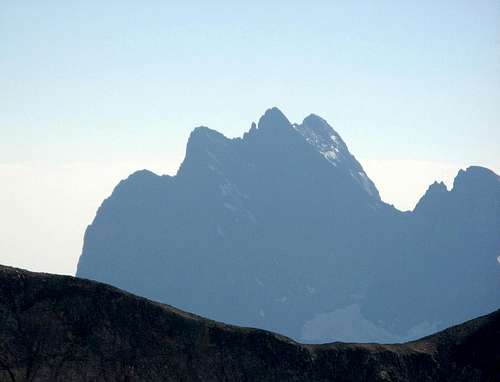
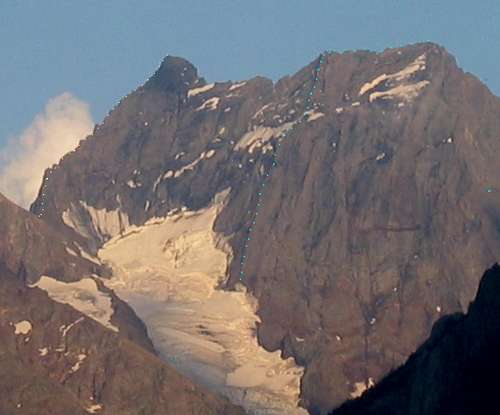

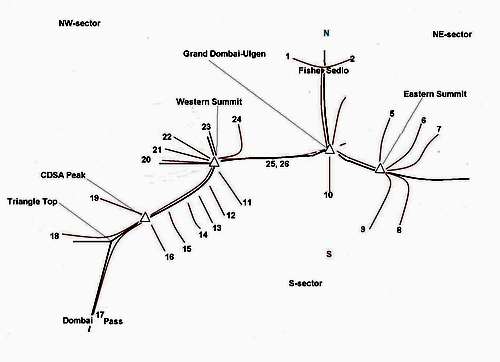

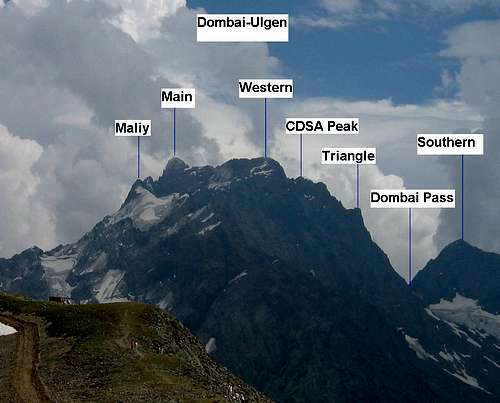
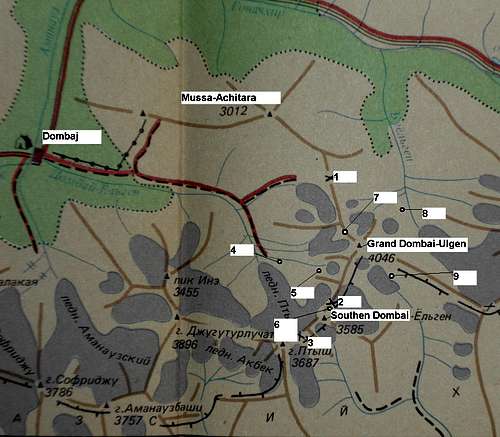

Sergey - Jun 26, 2020 2:47 am - Hasn't voted
New report S.Wall W.Dombai climbsNew report about S.Wall W.Dombai climbs made from 2000 to 2007 posted on www.risk.ru https://risk.ru/blog/218330